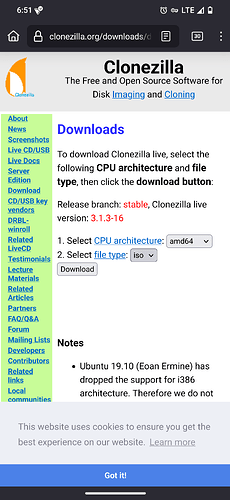╭─ion@SMA in ~ took 18ms
╰─λ garuda-inxi
System:
Kernel: 6.6.40-2-lts arch: x86_64 bits: 64 compiler: gcc v: 14.1.1
clocksource: hpet avail: acpi_pm
parameters: BOOT_IMAGE=/@/boot/vmlinuz-linux-lts
root=UUID=c6251b33-c81f-43de-b1fc-a36db6234086 rw rootflags=subvol=@
quiet loglevel=3 ibt=off
Desktop: Xfce v: 4.18.1 tk: Gtk v: 3.24.43 wm: xfwm4 v: 4.18.0
with: xfce4-panel tools: xfce4-screensaver avail: xautolock vt: 7
dm: LightDM v: 1.32.0 Distro: Garuda base: Arch Linux
Machine:
Type: Desktop Mobo: Gigabyte model: B450M DS3H V2 v: x.x
serial: <superuser required> uuid: <superuser required> BIOS: American
Megatrends LLC. v: F62 date: 01/27/2022
CPU:
Info: model: AMD Ryzen 3 3200G with Radeon Vega Graphics bits: 64 type: MCP
arch: Zen/Zen+ note: check gen: 1 level: v3 note: check built: 2019
process: GF 12nm family: 0x17 (23) model-id: 0x18 (24) stepping: 1
microcode: 0x8108109
Topology: cpus: 1x cores: 4 smt: <unsupported> cache: L1: 384 KiB
desc: d-4x32 KiB; i-4x64 KiB L2: 2 MiB desc: 4x512 KiB L3: 4 MiB
desc: 1x4 MiB
Speed (MHz): avg: 1927 high: 3600 min/max: 1400/3600 boost: enabled
scaling: driver: acpi-cpufreq governor: schedutil cores: 1: 1339 2: 1372
3: 1400 4: 3600 bogomips: 28758
Flags: avx avx2 ht lm nx pae sse sse2 sse3 sse4_1 sse4_2 sse4a ssse3 svm
Vulnerabilities: <filter>
Graphics:
Device-1: AMD Picasso/Raven 2 [Radeon Vega Series / Radeon Mobile Series]
vendor: Gigabyte driver: amdgpu v: kernel arch: GCN-5 code: Vega
process: GF 14nm built: 2017-20 pcie: gen: 3 speed: 8 GT/s lanes: 16
ports: active: HDMI-A-1 empty: DVI-D-1 bus-ID: 06:00.0 chip-ID: 1002:15d8
class-ID: 0300 temp: 28.0 C
Device-2: Microdia Integrated Camera driver: uvcvideo type: USB rev: 2.0
speed: 480 Mb/s lanes: 1 mode: 2.0 bus-ID: 1-2:3 chip-ID: 0c45:64ab
class-ID: 0e02
Display: x11 server: X.Org v: 21.1.13 compositor: xfwm4 v: 4.18.0 driver:
X: loaded: amdgpu unloaded: modesetting alternate: fbdev,vesa dri: radeonsi
gpu: amdgpu display-ID: :0.0 screens: 1
Screen-1: 0 s-res: 1152x864 s-dpi: 96 s-size: 305x229mm (12.01x9.02")
s-diag: 381mm (15.02")
Monitor-1: HDMI-A-1 mapped: HDMI-A-0 model: Acer 0x0019 serial: <filter>
built: 2009 res: 1152x864 hz: 75 dpi: 7 gamma: 1.2
size: 4095x4095mm (161.22x161.22") diag: 434mm (17.1") ratio: 5:4, 4:3
modes: max: 720x480 min: 720x400
API: Vulkan v: 1.3.279 layers: 5 device: 0 type: integrated-gpu name: AMD
Radeon Vega 8 Graphics (RADV RAVEN) driver: mesa radv v: 24.1.4-arch1.2
device-ID: 1002:15d8 surfaces: xcb,xlib device: 1 type: cpu name: llvmpipe
(LLVM 18.1.8 256 bits) driver: mesa llvmpipe v: 24.1.4-arch1.2 (LLVM
18.1.8) device-ID: 10005:0000 surfaces: xcb,xlib
API: OpenGL Message: Unable to show GL data. glxinfo is missing.
Audio:
Device-1: AMD Raven/Raven2/Fenghuang HDMI/DP Audio driver: snd_hda_intel
v: kernel pcie: gen: 3 speed: 8 GT/s lanes: 16 bus-ID: 06:00.1
chip-ID: 1002:15de class-ID: 0403
Device-2: AMD Family 17h/19h HD Audio vendor: Gigabyte
driver: snd_hda_intel v: kernel pcie: gen: 3 speed: 8 GT/s lanes: 16
bus-ID: 06:00.6 chip-ID: 1022:15e3 class-ID: 0403
API: ALSA v: k6.6.40-2-lts status: kernel-api tools: N/A
Server-1: sndiod v: N/A status: off tools: aucat,midicat,sndioctl
Server-2: PipeWire v: 1.2.1 status: active with: 1: pipewire-pulse
status: active 2: wireplumber status: active 3: pipewire-alsa type: plugin
4: pw-jack type: plugin tools: pactl,pw-cat,pw-cli,wpctl
Network:
Device-1: Realtek RTL8111/8168/8211/8411 PCI Express Gigabit Ethernet
vendor: Gigabyte driver: r8169 v: kernel pcie: gen: 1 speed: 2.5 GT/s
lanes: 1 port: f000 bus-ID: 04:00.0 chip-ID: 10ec:8168 class-ID: 0200
IF: enp4s0 state: up speed: 100 Mbps duplex: full mac: <filter>
Info: services: NetworkManager,systemd-timesyncd
Drives:
Local Storage: total: 1.82 TiB used: 160.59 GiB (8.6%)
SMART Message: Required tool smartctl not installed. Check --recommends
ID-1: /dev/sda maj-min: 8:0 vendor: Seagate model: ST9500325AS
size: 465.76 GiB block-size: physical: 512 B logical: 512 B speed: 1.5 Gb/s
tech: HDD rpm: 5400 serial: <filter> fw-rev: BSM1 scheme: MBR
ID-2: /dev/sdb maj-min: 8:16 vendor: Seagate model: ST1000DM010-2EP102
size: 931.51 GiB block-size: physical: 4096 B logical: 512 B speed: 6.0 Gb/s
tech: HDD rpm: 7200 serial: <filter> fw-rev: CC46 scheme: GPT
ID-3: /dev/sdc maj-min: 8:32 vendor: Crucial model: CT500MX500SSD1
size: 465.76 GiB block-size: physical: 4096 B logical: 512 B speed: 6.0 Gb/s
tech: SSD serial: <filter> fw-rev: 045 scheme: GPT
Partition:
ID-1: / raw-size: 465.76 GiB size: 465.76 GiB (100.00%)
used: 37.37 GiB (8.0%) fs: btrfs dev: /dev/sda1 maj-min: 8:1
ID-2: /home raw-size: 465.76 GiB size: 465.76 GiB (100.00%)
used: 37.37 GiB (8.0%) fs: btrfs dev: /dev/sda1 maj-min: 8:1
ID-3: /var/log raw-size: 465.76 GiB size: 465.76 GiB (100.00%)
used: 37.37 GiB (8.0%) fs: btrfs dev: /dev/sda1 maj-min: 8:1
ID-4: /var/tmp raw-size: 465.76 GiB size: 465.76 GiB (100.00%)
used: 37.37 GiB (8.0%) fs: btrfs dev: /dev/sda1 maj-min: 8:1
Swap:
Kernel: swappiness: 133 (default 60) cache-pressure: 100 (default) zswap: no
ID-1: swap-1 type: zram size: 5.71 GiB used: 0 KiB (0.0%) priority: 100
comp: zstd avail: lzo,lzo-rle,lz4,lz4hc,842 max-streams: 4 dev: /dev/zram0
Sensors:
System Temperatures: cpu: 28.4 C mobo: 27.0 C gpu: amdgpu temp: 28.0 C
Fan Speeds (rpm): N/A
Info:
Memory: total: 6 GiB available: 5.71 GiB used: 1.82 GiB (32.0%)
Processes: 268 Power: uptime: 10m states: freeze,mem,disk suspend: deep
avail: s2idle wakeups: 0 hibernate: platform avail: shutdown, reboot,
suspend, test_resume image: 2.27 GiB services: upowerd,xfce4-power-manager
Init: systemd v: 256 default: graphical tool: systemctl
Packages: pm: pacman pkgs: 1440 libs: 429 tools: paru pm: flatpak pkgs: 0
Compilers: gcc: 14.1.1 Shell: garuda-inxi default: Bash v: 5.2.26
running-in: xfce4-terminal inxi: 3.3.35
Garuda (2.6.26-1):
System install date: 2024-02-04
Last full system update: 2024-07-24
Is partially upgraded: No
Relevant software: snapper NetworkManager dracut
Windows dual boot: <superuser required>
Failed units:
╭─ion@SMA in ~ took 7s
╰─λ
I have it on an old spinning drive and want to move it to an existing available parttion on an SSD (same motherboard) without losing my user settings or installed software. I can modify /etc/fstab to reflect changed drives. What else must I do?
Thanks in advance.

